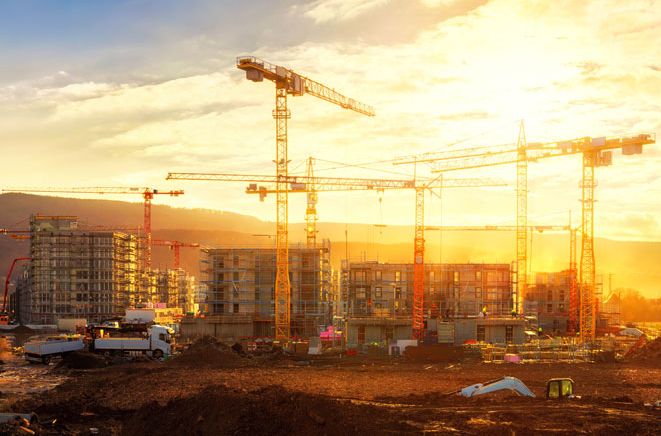What is line information required for?
If you as the client, construction company or engineering firm are planning to carry out earthworks, the planning phase is very important in order to avoid damage to the building. Damage can occur if you have not checked whether and at what depth possible supply lines run through your construction site and if these are hit during the earthworks. Supply lines can relate to, for example, electricity, district heating, telephone, gas or water. These can be buried anywhere, whether under roads, paths, pavements, meadows or even under private property. Consequently, it makes no difference whether it is a public or private property, line information is always required for the corresponding building and construction measures:

„line information“, „Plan information“ etc. – the most important terms
If you want to find out about the term „line information“ you will usually also come across the terms „plan information“, „route information“, „sector information“ or „network information“. These all have the same meaning. This is always information about the location of a network operator’s pipes or cables that are required for construction. In some cases, the location and type of lines (electricity, gas, water, etc.) are indicated and shown on a map. In addition, a safety instruction is often added to indicate which requirements of the network operator must be observed when working in the area of the lines.

Another important designation or specification is the shaft certificate or permit. This represents the network operator’s authorisation to carry out earthworks in the requested area. As a prerequisite for the shaft certificate, an excavation notification (a separate notification of the start of building/ construction) and a briefing appointment are usually required. At the briefing appointment, the route of the pipeline is shown and safety measures are pointed out. This is recorded in a protocol.
How should line information be obtained?
You should enquire with the relevant authorities about the location of supply lines in good time before starting the excavation work (at least two weeks in advance). Line information can be obtained from the network operators__, i.e. from the local utility providers or from the telecommunications services. Although the network operator is also obliged to prevent damage to its network and to provide planning information about its lines, contacting the responsible operators is often time-consuming. This is due to the fact that it is not always known which lines are laid where by which operator, how the operators can be contacted and who exactly is responsible. As there is neither an authority nor a public register where all operators are listed, the research is very tedious.

Where can I get information?
Firstly, you should contact the civil engineering office in your municipality. In the best case scenario, they will provide a list of utility providers and advise you on the phone which network operators need to be notified. To search for other network operators on the Internet, you can enter terms such as “plan information”, “route information”, “shaft certificate”, “section information”, “external line plans” or “network information” with the name of the city where the construction site is located. If you reach the desired employees of the network operators (such as the local municipal utility providers), it is advisable to enquire whether there are any other utility providers known in the area.
What do I have to provide?
Once you have obtained detailed information, you should next draw up a site plan of the construction site. This must be clear enough to be easily understood by the network operators concerned. In addition, make a list that gives more precise details of the construction site. Important points here are:
- Project name
- Address of the construction project
- Project description
- Detailed location description
- Type of activity
- Type of civil engineering
- Expected start of construction
- Expected end of construction
- Client of the construction project
- Construction company carrying out the work
Send both documents to the network operators. If you then receive the relevant line information, you should then create a folder containing all documents and contacts.
Where can I request alternative line information?
Together with our partner LAO, we offer you the full service package for line information. Here, the communication and coordination with each individual network operator is taken care of for you. The entire process of obtaining line information is handled by experts.
contact
Are you a commercial customer and regularly need property-related information?
line information: FAQ
How can I check locally whether other network operators exist?
Yellow signposts, blue signs for water or markers indicate the existence of possible additional lines.
Do I have to obtain line information?
Yes, you can only be sure that the infrastructure will not be destroyed if you are sufficiently informed about the location of the lines and pipes in the ground. Care must be taken when working with gas, electricity and water lines in particular, as they pose a particular risk.
What is a shaft certificate?
You will receive a shaft certificate from the network operator. This authorises you to carry out earthworks in a specific area in which the operator’s lines run.
Can the network operator refuse to hand over line information?
If you are planning a civil engineering project, the network operator is obliged to prevent damage to its network as part of its maintenance and operating obligations and must therefore provide planning information about its lines to enquirers with legitimate interests.
How much do I have to pay for line information?
A few utility providers charge an expense allowance. However, it is often debated whether the provision of planning information should be free of charge. Most utility providers do not charge any fees or costs and usually provide the line information on online portals.
How deep do pipes and lines lay?
The position and depth of the lines can vary due to soil erosion, soil movements, backfills or other circumstances. In general, however, the depth of cable and gas lines is approximately 60 to 120 cm. House connection pipes in particular can also lay higher.
